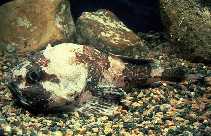http://www.fishbase.org/Summary/speciesSummary.php?genusname=Cottunculus&speciesname=microps ---> http://192.134.151.83/Summary/speciesSummary.php?genusname=Cottunculus&speciesname=microps
http://192.134.151.83/Summary/speciesSummary.php?genusname=Cottunculus&speciesname=microps ---> https://fishbase.mnhn.fr/Summary/speciesSummary.php?genusname=Cottunculus&speciesname=microps
https://fishbase.mnhn.fr/Summary/speciesSummary.php?genusname=Cottunculus&speciesname=microps ---> https://fishbase.mnhn.fr/summary/Cottunculus-microps.html
Cottunculus microps, Polar sculpin

You can
sponsor
this page
Common name (e.g. trout)
Genus + Species (e.g. Gadus morhua)
-

-
About this page
-
Languages
-
User feedbacks
-
Citation
-
Uploads
-
Related species
-


 Polar sculpin
Add your observation in
Fish Watcher
Upload your
photos
and
videos
Polar sculpin
Add your observation in
Fish Watcher
Upload your
photos
and
videos
Pictures
|
Google image
 Cottunculus microps
Cottunculus microps
Picture by
Zimmermann, C.
Teleostei (teleosts) >
Perciformes/Cottoidei
(Sculpins) >
Psychrolutidae
(Fatheads)
Etymology:
Cottunculus:
Greek, kottos = a fish, diminutive
.
Environment: milieu / climate zone / depth range / distribution range
Ecology
Marine; bathydemersal; depth range 165 - 1342 m (Ref.
58426
), usually 165 - 215 m (Ref.
42091
). Deep-water; 79°N - 38°N, 76°W - 36°E
North Atlantic: English Channel, North Sea, Norwegian coastline, Svalbard, southwestern Barents Sea, off Spitzbergen, Bear Island, the Faeroes and Iceland, southeastern coasts of Greenland. Western Atlantic: New Jersey, USA to Gulf of St. Lawrence, Canada and Greenland.
Size / Weight / Age
Maturity: L
m
?
range ? - ? cm
Max length : 30.0 cm SL male/unsexed; (Ref.
35388
); common length : 14.0 cm SL male/unsexed; (Ref.
6696
)
Short description
Morphology
|
Morphometrics
Four bony knobs between and behind the eyes. Skin very rough. Body with 3-4 broad, dark vertical bands (Ref.
35388
).
Benthic (Ref.
58426
). Feeds on polychaetes, mysids, amphipods and pycnogonids. Spawns probably from June to July, ovarian eggs large and few (up to 220) (Ref.
6696
). Female lays 200 eggs with a length of 4.5-5 mm (Ref.
35388
).
Life cycle and mating behavior
Maturity
|
Reproduction
|
Spawning
|
Eggs
|
Fecundity
|
Larvae
Fedorov, V.V. and J.S. Nelson
, 1986. Psychrolutidae. p. 1261-1264. In P.J.P. Whitehead, M.-L. Bauchot, J.-C. Hureau, J. Nielsen and E. Tortonese (eds.) Fishes of the North-eastern Atlantic and the Mediterranean. UNESCO, Paris. Vol 3. (Ref.
6696
)
IUCN Red List Status (Ref.
130435
)
Not Evaluated
CITES
Not Evaluated
Not Evaluated
Threat to humans
Harmless
Human uses
Fisheries: of no interest
FAO - Publication:
search
|
FishSource
|
More information
Countries
FAO areas
Ecosystems
Occurrences
Introductions
Stocks
Ecology
Diet
Food items
Food consumption
Ration
Common names
Synonyms
Metabolism
Predators
Ecotoxicology
Reproduction
Maturity
Spawning
Spawning aggregation
Fecundity
Eggs
Egg development
Age/Size
Growth
Length-weight
Length-length
Length-frequencies
Morphometrics
Morphology
Larvae
Larval dynamics
Recruitment
Abundance
BRUVS
References
Aquaculture
Aquaculture profile
Strains
Genetics
Electrophoreses
Heritability
Diseases
Processing
Nutrients
Mass conversion
Collaborators
Pictures
Stamps, Coins Misc.
Sounds
Ciguatera
Speed
Swim. type
Gill area
Otoliths
Brains
Vision
Tools
Bio-Quiz
|
E-book
|
Field guide
|
Length-frequency wizard
|
Life-history tool
|
Point map
|
Classification Tree
|
Catch-MSY
|
Special reports
Check for Aquarium maintenance
|
Check for Species Fact Sheets
|
Check for Aquaculture Fact Sheets
Download XML
Summary page
|
Point data
|
Common names
|
Photos
Internet sources
AFORO (otoliths)
|
Aquatic Commons
|
BHL
|
Cloffa
|
BOLDSystems
|
Websites from users
|
Check FishWatcher
|
CISTI
|
Catalog of Fishes
:
genus
,
species
|
DiscoverLife
|
DORIS
|
ECOTOX
| FAO - Publication:
search
|
Faunafri
| Fishipedia |
Fishtrace
| GenBank:
genome
,
nucleotide
|
GloBI
|
Google Books
|
Google Scholar
|
Google
| IGFA World Record |
MitoFish
|
National databases
|
Otolith Atlas of Taiwan Fishes
|
PubMed
| Reef Life Survey | Socotra Atlas |
Tree of Life
| Wikipedia:
Go
,
Search
| World Records Freshwater Fishing |
Zoobank
|
Zoological Record
Estimates based on models
Preferred temperature (Ref.
123201
): 0.3 - 7.7, mean 2.6 °C (based on 243 cells).
Phylogenetic diversity index (Ref.
82804
): PD
50
= 0.5039 [Uniqueness, from 0.5 = low to 2.0 = high].
Bayesian length-weight: a=0.00389 (0.00180 - 0.00842), b=3.12 (2.94 - 3.30), in cm total length, based on all LWR estimates for this body shape (Ref.
93245
).
Trophic level (Ref.
69278
): 4.1 ±0.2 se; based on diet studies.
Resilience (Ref.
120179
): Low, minimum population doubling time 4.5 - 14 years (Fec = 66).
Fishing Vulnerability (Ref.
59153
): Low to moderate vulnerability (27 of 100).
Nutrients (Ref.
124155
): Calcium = 20.5 [5.0, 69.0] mg/100g; Iron = 0.431 [0.149, 1.080] mg/100g; Protein = 14.8 [12.5, 17.8] %; Omega3 = 0.349 [0.133, 0.959] g/100g; Selenium = 12.6 [4.4, 43.1] μg/100g; VitaminA = 16.5 [3.4, 78.4] μg/100g; Zinc = 0.423 [0.217, 0.837] mg/100g (wet weight);
Back to Search
Random Species
Back to Top
Accessed through:
Not available
FishBase mirror site :
localhost
Page last modified by :
mrius-barile
- 20 July 2016
Fatal error
: Uncaught ArgumentCountError: Too few arguments to function checkEcotox(), 1 passed in /var/www/html/summary/speciessummary.php on line 2304 and exactly 3 expected in /var/www/html/includes/speciessummary.lib.php:2579 Stack trace: #0 /var/www/html/summary/speciessummary.php(2304): checkEcotox() #1 {main} thrown in
/var/www/html/includes/speciessummary.lib.php
on line
2579
|